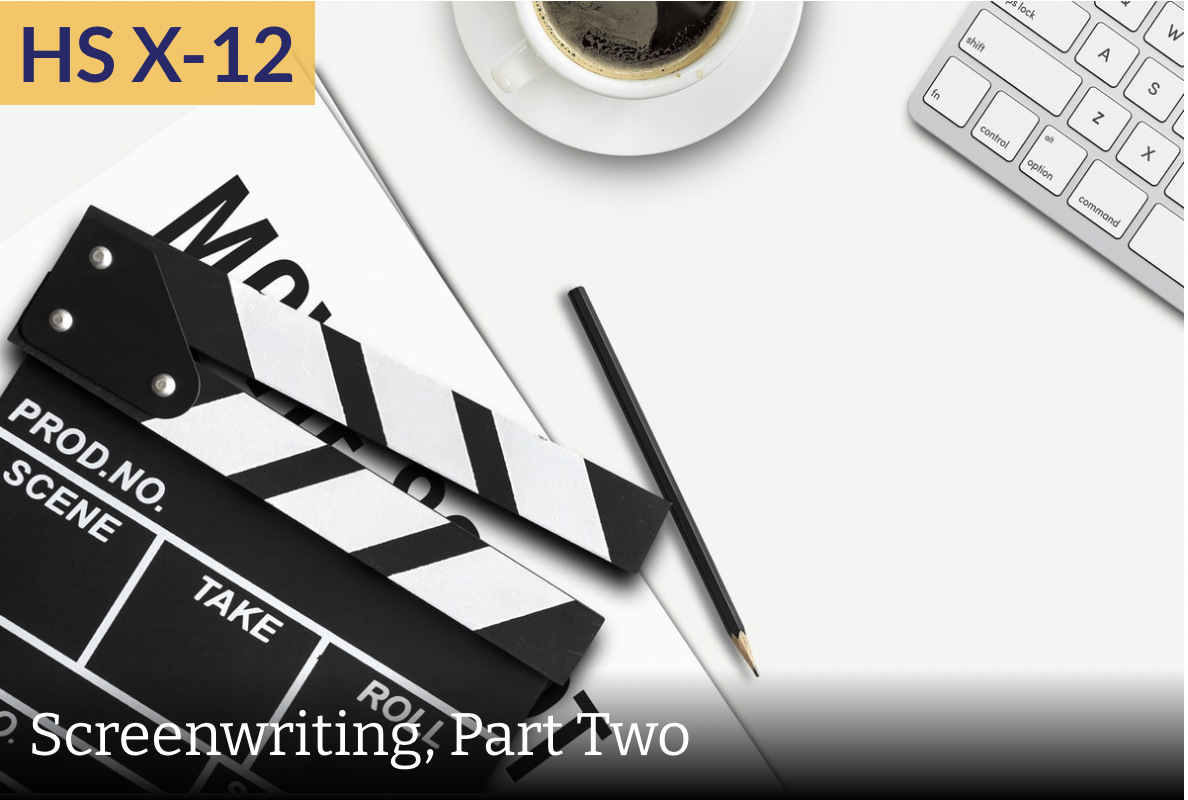
In this hands-on writing course, practice your advanced writing skills and learn how to design stories for film! Write dynamic loglines, craft powerful story outlines in beat sheets, create dynamic scenes that grab the reader, and know what it takes to write for film. Especially if you want to explore writing as a part or full-time career, this course is for you...
Currently, Instructor Access grading services are not available for this course.

NOTICE: This is an older course recorded with Adobe Connect and/or Vimeo recordings.
We are currently working to replace the recordings with new Zoom recordings.
Please don't hesitate to email us at homeschoolconnections@gmail.com with any questions.
For students who want to excel in fiction writing skills and jumpstart college literature courses; this is both a college and career preparatory course.
Sign up for Screenwriting Parts One and Two together, to complete the requisite book; the course is complete with both semesters.
How to Get the Most Out of Fiction Writing: Screenwriting, Part Two with Erin M. Brown (AKA Erin Brown Conroy/E.B. Conroy):
|
Total classes: 8
Duration: 55 minutes
Prerequisite: Screenwriting I or instructor permission, a thirst to create, and a love of story in movies! Your student will also need Word 2007 or later version or the ability to convert a document to a Word-compatible document.
Suggested grade level: 9th to 12th grade
Suggested credit: 2/3 Screenwriting, Creative Writing, or English. For a full credit keep writing daily and working your craft.
Instructor: Erin Brown Conroy, MA, MFA
Course description: In your Advanced Fiction Writing Introduction to Screenwriting Part 2 course, you’ll continue to learn all of the key foundations of screenwriting and creating scripts for movies — including the business of film in Hollywood. Find out more about what goes into designing stories for film — including how to craft excellent character development and create a powerful storyline. While learning and practicing the special skills of writing for film, you will continue to read through screenplays; watch and analyze classic and current films; watch additional videos related to learning the craft; discuss the conventions of good movies; learn how to craft masterful dialogue; and craft your own scenes and screenplay.
Course outline:
- Class 1: The Beat Sheet, Film Analysis, and Shorts (Chapter Four)
- Class 2: Putting Ideas into Loglines and Beat Sheets
- Class 3: The Beat Sheet as a Business Plan (Chapter Five) and More on Script Dialogue
- Class 4: Crafting Scenes and The Hollywood Rules of Screenplays 1 (Chapter Six)
- Class 5: Crafting Scenes and The Hollywood Rules of Screenplays 2 (Chapter Six)
- Class 6: “Script Repair” (Chapter Seven)
- Class 7: The Business of Screenwriting (Chapter Eight)
- Class 8: Final Short Screenplay Discussions
Course materials: Word 2007 or later version. BOOK 1: The Writer’s Journey: Mythic Structures for Writers, 3rd Edition, by Christopher Vogler and Michele Montez. Get the book here: http://amzn.to/2DzkE1W. NOTE: The same book is used in both of the Advanced Fiction (Parts One and Two) courses.
AND, BOOK 2: Save the Cat, by Blake Snyder. Get the book here: http://amzn.to/2GwDM3n.
Homework: Students will read from the text, read posted articles, complete pre-scene exercises, and write loglines, outlines (beat sheets), and scenes. The final project is in the second semester is a short script (12 to 15 pages). Time spent working on homework varies between individuals and their writing skills and speed. Students can expect to spend an average of two and four hours a week on homework. For the final project, students may spend more time.
- Teacher: E B Conroy
- Teacher: Bonnie Donlon
- Teacher: Donna Graziose
- Teacher: Aubrey Heki
- Teacher: Doug Hughes
- Teacher: Sharon Weis